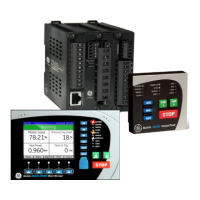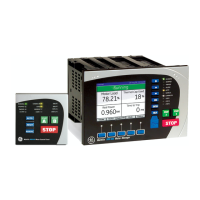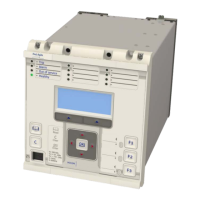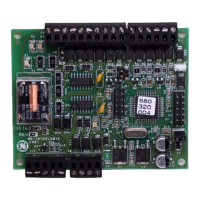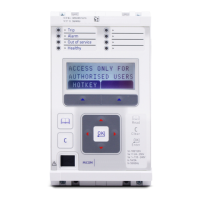4.11 ETHERNET METALLIC CONNECTIONS
If the device has a metallic Ethernet connection, it can be connected to either a 10Base-T or a 100Base-TX
Ethernet hub. Due to noise sensitivity, we recommend this type of connection only for short distance connections,
ideally where the products and hubs are in the same cubicle. For increased noise immunity, CAT 6 (category 6) STP
(shielded twisted pair) cable and connectors can be used.
The connector for the Ethernet port is a shielded RJ-45. The pin-out is as follows:
Pin Signal name Signal definition
1 TXP Transmit (positive)
2 TXN Transmit (negative)
3 RXP Receive (positive)
4 - Not used
5 - Not used
6 RXN Receive (negative)
7 - Not used
8 - Not used
4.12 ETHERNET FIBRE CONNECTIONS
We recommend the use of fibre-optic connections for permanent connections in a substation environment. The
100 Mbps fibre optic port uses type ST connectors (one for Tx and one for Rx), compatible with 50/125 µm or
62.5/125 µm multimode fibres at 1300 nm wavelength.
Note:
For models equipped with redundant Ethernet connections the product must be partially dismantled to set the fourth octet of
the second IP address. This ideally, should be done before installation.
4.13
RS232 CONNECTION
Short term connections to the EIA(RS)232 port, located behind the bottom access cover, can be made using a
screened multi-core communication cable up to 15 m long, or a total capacitance of 2500 pF. The cable should be
terminated at the product end with a standard 9-pin D-type male connector.
4.14
DOWNLOAD/MONITOR PORT
Short term connections to the download/monitor port, located behind the bottom access cover, can be made
using a screened 25-core communication cable up to 4 m long. The cable should be terminated at the product end
with a 25-pin D-type male connector.
4.15
GPS FIBRE CONNECTION
Some products use a GPS 1 PPS timing signal. If applicable, this is connected to a fibre-optic port on the
coprocessor board in slot B. The fibre-optic port uses an ST type connector, compatible with fibre multimode
50/125 µm or 62.5/125 µm – 850 nm.
4.16
FIBRE COMMUNICATION CONNECTIONS
The fibre optic port consists of one or two channels using ST type connectors (one for Tx and one for Rx). The type
of fibre used depends on the option selected.
850 nm and 1300 nm multimode systems use 50/125 µm or 62.5/125 µm multimode fibres. 1300 nm and 1550 nm
single mode systems use 9/125 µm single mode fibres.
P543i/P545i Chapter 24 - Installation
P54x1i-TM-EN-1 629
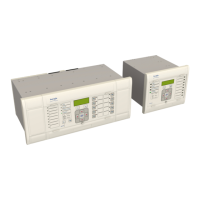
